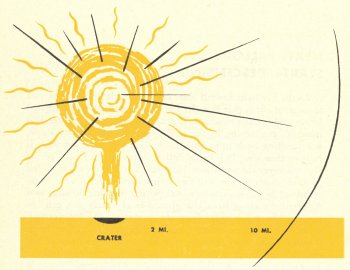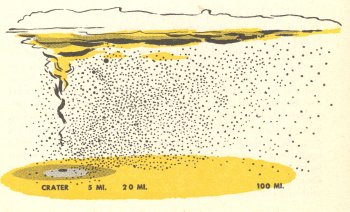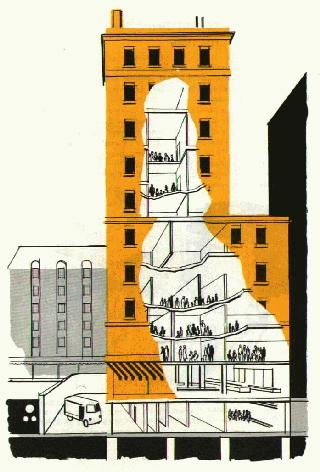Fallout Protection
What To Know and Do About Nuclear Attack
GPO O-F-430280, 1957

HOW TO SURVIVE ATTACK AND LIVE FOR YOUR COUNTRY'S RECOVERY
The purpose of this booklet is to help save lives if a nuclear attack should ever come to America. The foreign and defense policies of your Government make such an attack highly unlikely, and to keep it unlikely is their most important aim. It is for this reason that we have devoted so large an effort to creating and maintaining our deterrent forces. However, should a nuclear attack ever occur, certain preparations could mean the difference between life and death for you.
The need for preparation, for civil defense, is likely to be with us for a long time, and we must suppress the temptation to reach out hastily for short-term solutions. There is no panacea for protection from nuclear attack. In a major attack upon our country, millions of people would be killed. There appears to be no practical program that would avoid large-scale loss of life. But an effective program of civil defense could save the lives of millions who would not otherwise survive. Fallout shelters and related preparations, for example, could greatly reduce the number of casualties.
President Kennedy, speaking on July 25, 1961, put it this was: "In the event of attack, the lives of those families which are not hit in the nuclear blast and fire can still he saved if they can he warned to take shelter and if that shelter is available. We owe that kind of insurance to our families and to our country."
The President was talking about shelter from radioactive fallout. The blast, heat, and fire of a nuclear explosion are appallingly destructive. But radioactive fallout could spread over thousands of square miles, covering a much greater area than the area endangered by fire and blast. Fallout would be a potential killer of millions of unprotected persons, but it also is a hazard that individuals and communities can prepare for through reasonable programs and actions. A fallout shelter program is one of these. This booklet contains information about a shelter program, what the Federal Government intends to do, and how State and local governments, and individual citizens can work together to bring it into being as a sound measure of national preparedness.
There is much we can do together, and perhaps the first step is to take a clear look at nuclear warfare and what it could mean to the world as we know it today.
There is no escaping the fact that nuclear conflict would leave a tragic world. She areas of blast and fire would be scenes of havoc, devastation, and death. For the part of the couryside outside the immediate range of the explosions, it would be a time of extraordinary hardship, both for the Nation and for the individual. The effects of fallout radiation would be present in areas not decontaminated. Transportation and communication would be disrupted. The Nation would be prey to strange rumors and fears. But if effective precautions have been taken in advance, it need not be a time of despair.
These are somber subjects, and they presuppose a catastrophe which can be made very unlikely by wise and positive policies, pursued with imagination and faith. Still, realistic preparation for what might happen is far more useful than blindness, whether from fear or ignorance. A sane and sober person can assume that, whatever comes to pass, he would draw on his reserve of courage and intelligence and the unquenchable will to live and begin to build again.
The experience would be terrible beyond imagination and description. But there is much that can be done to assure that it would not mean the end of the life of our Nation.
There are no total answers, no easy answers, no cheap answers to the question of protection front nuclear attack But there are answers. Some of them are in this booklet.
A NUCLEAR EXPLOSION: FIRST, THE BLAST
A five-megaton nuclear weapon explodes with a brilliant flash that lasts about a minute. A quick burst of nuclear and heat radiation emerges from ground zero, the point of the explosion. The spurt of nuclear radiation (wavy lines extending from the fireball) is called initial radiation or prompt radiation and kills within a mile or two. The heat rays (straight lines) can kill unprotected people up to 10 miles away and may start fires beyond that. The heat rays and initial radiation are fol· lowed by a blast wave which starts at more than 2,000 miles an hour, but loses much of its damaging force by about 10 miles out. With the blast wave comes a violent wind which picks up loose objects and bears them outward. In the illustration here, the weapon has burst at ground level, leaving a crater about half a mile across and 200 feet deep. Nearly everything within a radius of a mile of ground zero would be destroyed.

NEXT: FALLOUT STARTS DESCENDING
As the brilliant fireball rises in the sky, it draws up a vast amount of earth that is melted or vaporized and contaminated by the radioactive residue of the explosion. A little later this material, condensing in the cold upper air like rain or snow, starts falling back to earth because, like ash from a fire, it is heavier than air. It is called fallout because it falls out of the sky, wherever the winds may blow it. You cannot tell from the ground which way it will be carried because its scatter is determined by high-altitude winds, which may be blowing in a different direction from the ground-level winds you can observe. About five miles from the explosion, the heavier particles-early fallout-would reach the ground in half an hour.
Twenty miles away, people may have nearly an hour to get ready. One hundred miles away the fallout may not start for four to six hours. All this early fallout, which carries the bulk of the radiation danger, descends in less than 24 hours. The less dangerous 'lighter particles-delayed fallout-might stay aloft for months.

A CITY BUILDING PROVIDES FALLOUT PROTECTION
After a nuclear attack, a tall apartment or office building 10 miles or more from the explosion could be one of the safest refuges. In this drawing the people hase taken shelter from radioactive fallout in an office building.
Because the gamma rails given off by fallout penetrate much like X-rays, the people taking shelter in the building shown on the opposite page have put as much mass of material as possible between themselves and the particles which have settIed on the roof, ground, and other horizontal surfaces. Above ground, they have gone to the middle of the building, below ground, they have found shielding in a basement corner. Those in the main basement are shielded from radiation by the surrounding earth, by partitions, and by the whole mass of the building above. On the upper floors, people have shielded themselves in the "core" of the building. There have avoided the floor with the setback and terrace because of radiation from the fallout piling up there. (For better protection on any floor, it is advisable to keep below the windowsill level.) Because the tall building shields lower floors from some radiation, people have taken shelter in more rooms on that side. But no one has taken cover on the ground and top floors because the shielding there is inadaquate.
